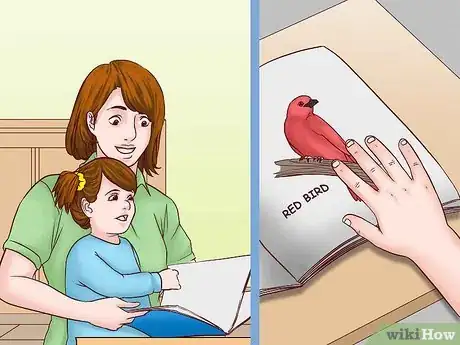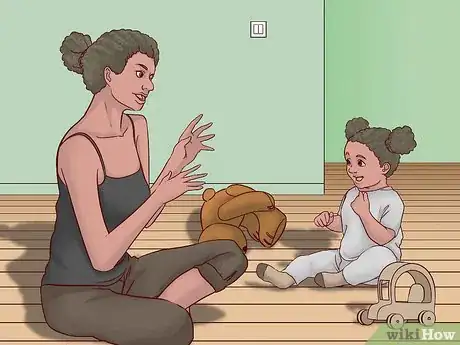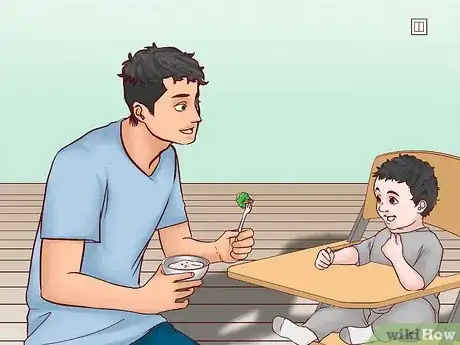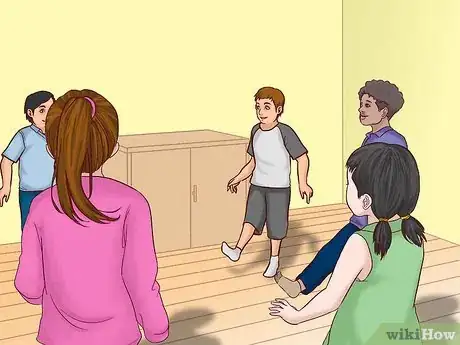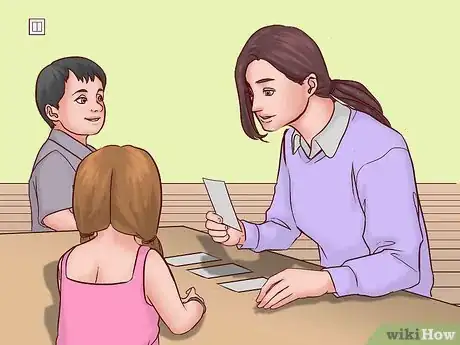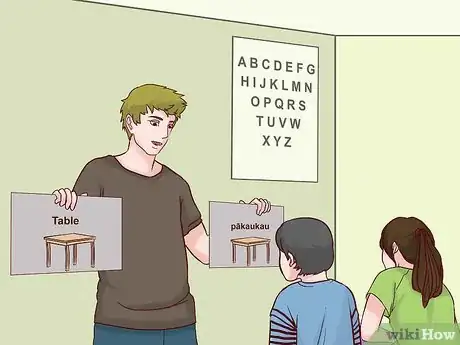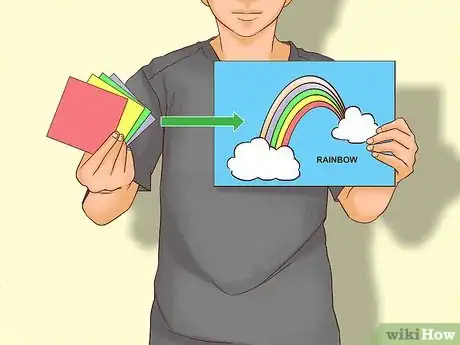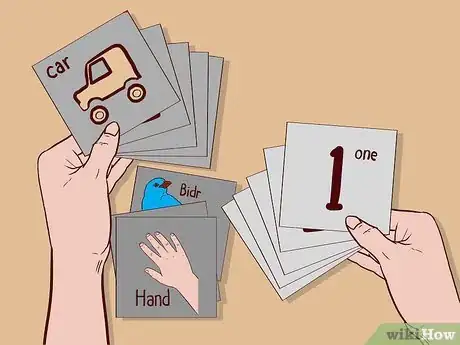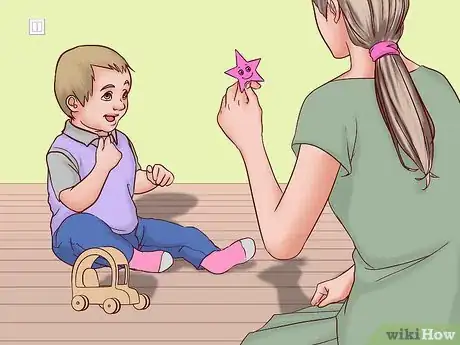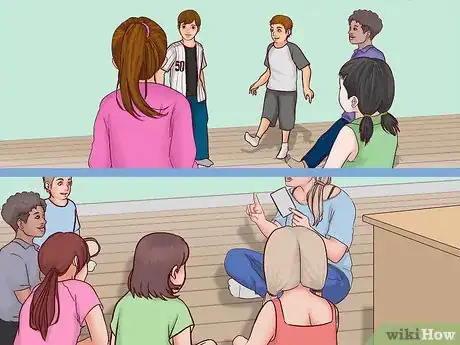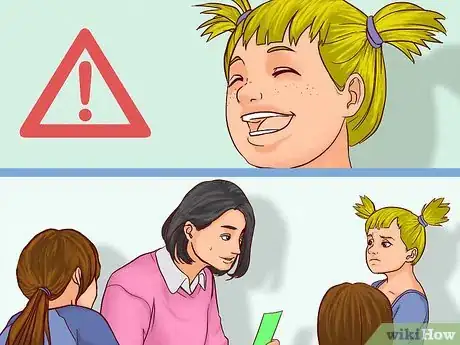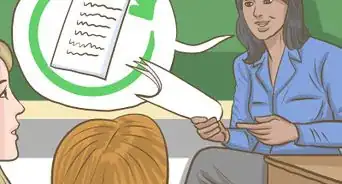This article was co-authored by Alexander Ruiz, M.Ed. and by wikiHow staff writer, Christopher M. Osborne, PhD. Alexander Ruiz is an Educational Consultant and the Educational Director of Link Educational Institute, a tutoring business based in Claremont, California that provides customizable educational plans, subject and test prep tutoring, and college application consulting. With over a decade and a half of experience in the education industry, Alexander coaches students to increase their self-awareness and emotional intelligence while achieving skills and the goal of achieving skills and higher education. He holds a BA in Psychology from Florida International University and an MA in Education from Georgia Southern University.
There are 7 references cited in this article, which can be found at the bottom of the page.
This article has been viewed 20,749 times.
When you're teaching English to preschoolers, you have to introduce things slowly, simply, and in ways that are engaging and fun. If you’re a parent at home, model the use of English by narrating your activities, reading picture books, and singing songs. As a classroom teacher, meet the students’ unique learning abilities by using a wide range of games and activities. Whether you're teaching a classroom full of kids or instructing your own child at home, make sure to introduce English vocabulary logically and in context, and offer lots of encouragement and praise!
Steps
Introducing English at Home
-
1Narrate everyday situations in simple English. Introduce the child to English by letting them hear you speak it within the context of what you’re doing. For instance, say out loud to them, “Daddy is making some tea,” or, “Let’s rub the soap on our hands,” or, “I see you are playing with your doll Frankie.”[1]
- If English isn’t your first language, it’s still helpful for a child to hear you narrate situations to the degree that you can do so. It’s a good way to help you improve your English as well!
- If you don’t speak English, ask any family members or friends who do to act as a narrator when they’re around.
-
2Read them picture books while you point to the pictures. This is a classic way of introducing a language to small kids, and it’s still very effective today. Let them pick a favorite book with lots of pictures. As you read the words out loud, point to any pictures that correlate to the words—for instance, a picture of a bird when you read “the red bird.”[2]
- With young kids, point to the pictures so they associate the words they hear you say with the items you’re pointing at. When they’re ready to be introduced to reading, you can start pointing to the words as you read them.
- Encourage your child to participate. For instance, when you say “the red bird,” ask them to point to the bird (if they’re able to do so).
- Be prepared to read the same books over and over again!
Advertisement -
3Sing songs together to introduce vocabulary. Instead of just showing a younger child the alphabet, clap and sing your ABCs together as you look at the alphabet. You might also use an illustrated sing-along book full of favorite toddler tunes and point to the pictures of animals, objects, and people as you sing about them.[3]
- Sing nursery rhymes and silly songs together, and then try to come up with your own songs to sing together.
- If the child knows or is learning another language with an alphabet that suits the “ABCs Song,” like Spanish or French, you can sing both versions and point out the similarities and differences.
-
4Play games like “I Spy” that introduce English vocabulary. Incorporate learning into fun activities—kind of in the same way you might hide their vegetables in their favorite foods! Try games that involve one person asking questions or making commands, and the other person responding to them.[4]
- In a game of “I Spy,” for instance, you might say, “I spy something green,” and they have to guess what it is.
-
5Build a routine of short, frequent learning sessions. All children, and especially those under 5, have naturally short attention spans. Limit your reading sessions or other language-related activities to sessions of about 15 minutes. This will help them remain interested and engaged.[5]
- Aim to have short sessions every 2-3 hours throughout the day. Try having sessions right after a snack, not right before naptime—you want them attentive, not cranky!
- If you’re not available to provide frequent sessions throughout the day, work with the child’s other caregivers to develop a consistent learning routine.
- If the child is eager to extend a session, keep going! Just watch for signs that their interest or energy levels are waning.
Using Group or Classroom Activities
-
1Encourage active learning with group songs and dances. Keeping an entire group of young kids focused on anything is a challenge, so getting them moving around and having fun is a must! Build up a routine of vocabulary-building songs and dances that the entire class can do together consistently.[6]
- For example, sing songs that cover the days of the week and months of the year at the start of each day.[7]
- Turn fun dances like the “Hokey Pokey” into vocabulary exercises.
-
2Use crafts and activity sheets for hands-on vocabulary lessons. Make sure your English lessons are built around fun activities, and you'll greatly improve your odds of keeping everyone’s attention.[8] For example, spell out words with craft sticks or by drawing in sand to make it a tactile experience.[9]
- Build up a stockpile of coloring papers, activity sheets, craft supplies, and other similar materials. With a bit of searching, you can find many of these resources free online.[10]
-
3Read stories to the group that introduce words in a fun way. For example, pick out some books by Dr. Seuss and other great kids’ story rhyme-makers, such as Sandra Boynton, P.D. Eastman, and Shel Silverstein. Make sure you hold up the book and show the pictures while you read![11]
- In a classroom setting, it works well to have all the kids sit on the floor while you stand, read the book, and point to the pictures.
- You might ask the kids to bring in favorite books for you to read to everyone.
-
4Play fun group games like Simon Says. Simon Says is one of several easy, fun games you can use to teach English words. As “Simon,” you can ask the kids to “pick up a pencil,” “point to the tiger picture,” “draw the moon,” and so on.[12]
- You can also let them be Simon!
- Musical chairs is another good option since the kids have to listen closely to the song. It also helps them release some pent-up energy!
-
5Use vocabulary-building and age-appropriate games you find online. Along with classic group or classroom games, look for language games that kids can play on a computer or tablet. English literacy organizations may offer free interactive games online.[13]
- Some games can also serve as learning assessment tools for your use.
- If you only have access to one or a few tablets or computers, you may want to set up activity stations. That way, a few kids can use the computers while others do vocabulary themed art projects and group games. Then, everybody gets to move on to the next station.[14]
-
6Join in the activities instead of just observing them. Who says the kids have to have all the fun? Don’t just teach them the songs, sing along with them. Play the games with them, and let them come up with new word games to try out.[15]
- While it’s obviously your job to be in charge and keep things moving in the right direction, let the kids know and see that you’re having a good time, too.
- If the kids are losing interest or focus, be ready with another learning activity. Shift from a flash card game to a sing-along, for example.
-
7Use immersion, submersion, or a variation of these methods for ESL learners. There is no definitive consensus among educators about the best way to teach English as a second language (ESL) to younger kids. The methods known as “immersion” and “submersion” are the most common, but there are other options as well, and all methods have their pros and cons. For example:[16]
- Submersion is also known as “sink or swim” since instruction is done entirely in the second language (in this case, English). Some students learn faster this way, while others struggle.
- Immersion instructs in the second language (English), but the teacher knows the kids’ first language and can engage in it as needed. This helps some students along, but may unnecessarily slow the progress of others.
- Variations like “Structured Immersion” and “Two-Way Bilingual Immersion” combine aspects of immersion, submersion, and other methods.
Helping Kids Learn in Any Setting
-
1Introduce vocabulary and grammar in context, never in lists. Preschoolers aren’t ready to handle lists of English vocabulary words, and will quickly lose interest. Instead, add to their vocabulary within a context that they can easily grasp. For example, introduce food words while talking about what everyone had for breakfast, or introduce animal names while looking through a picture book of a zoo trip.[17]
- Don’t worry much yet about explaining particular grammar rules. Again, focus on introducing basic concepts in context: “I have one straw and you have 2 straws,” or, “I had a straw and now you have a straw.”
-
2Connect new teaching material to what they’ve already learned. When you introduce new material, circle back and connect it to words and concepts you’ve already introduced. This helps children build from what they already know, and also helps them strengthen their understanding through repetition.[18]
- For example, if you’re introducing color names, you can also reinforce their number vocabulary by counting and identifying the colors of a rainbow.
- You might ask them to remind you what you learned last time: “Before we start our word song for today, can you remind me of the words we sang about yesterday?”
-
3Emphasize basic vocabulary like numbers, colors, and foods. All kids learn differently and have unique interests, so introduce words that relate to things that are common in their lives and that excite them. In general, start with words from categories such as the following:[19]
- Numbers (1-10, etc.)
- Colors (red, blue, green, etc.)
- Foods (toast, cereal, milk, etc.)
- Toys (blocks, trains, dolls, etc.)
- Clothes (pants, socks, coat, etc.)
- Animals and pets (cow, bird, cat, etc.)
- The body (arms, head, feet, etc.)
- Adjectives (big, small, fast, slow, etc.)
-
4Offer stickers, high-fives, or other tangible rewards. Positive reinforcement works with individual kids as well as with groups. Saying things like, “great job!” or, “that was an excellent try” can do wonders for their confidence, as can handing out simple rewards for their efforts.[20]
- You might create a chart that the kids get to add stickers to whenever they become a “word champion” by achieving a specified goal.
-
5Tailor your methods to suit each child’s unique strengths. Whether it’s English, math, or tying shoes, every kid learns a bit differently. Don’t expect a one-size-fits-all approach to teaching English to work. Instead, observe kids closely and look for ways to teach to their unique strengths.[21] [22]
- One child may be an auditory learner and thrive when songs are used frequently, while another may be a visual learner and prefer flash cards and picture books.[23]
- Another child might be a kinesthetic learner and prefer to learn things in a more hands-on way.[24]
- When you’re working with a group or a classroom, mix and match the techniques you utilize to help you reach all the students.
-
6Be ready to adapt or change course right away. Small children are unpredictable—they can switch from calm and attentive to wild and crazy in the blink of an eye, or quickly go from loving a word game to hating it. Never get too stuck in your ways or insistent upon your schedule. Instead, always be ready to make slight adjustments to a game, or to switch from a song to a craft when needed.[25]
- There’s no doubt that the unpredictability of preschoolers can be frustrating, but it’s also one of their endearing qualities—you never know what you’re going to get!
Expert Q&A
-
QuestionHow can you help students remember the days of the week?
 Courtney CoprivizaCourtney Copriviza is an Elementary School Teacher based in Maui, HI. Courtney specializes in elementary education, classroom management, and social and emotional development. She holds a BA in Communication with a minor in Urban Education and an MA in Teaching from Santa Clara University. Courtney has also taught high school in Madrid, Spain. She is a member of Kappa Delta Pi International Honors Society in Education.
Courtney CoprivizaCourtney Copriviza is an Elementary School Teacher based in Maui, HI. Courtney specializes in elementary education, classroom management, and social and emotional development. She holds a BA in Communication with a minor in Urban Education and an MA in Teaching from Santa Clara University. Courtney has also taught high school in Madrid, Spain. She is a member of Kappa Delta Pi International Honors Society in Education.
Elementary School Teacher You can make up a song for the days of the week and sing it with the students. If you like, you can also make hand motions along with it.
You can make up a song for the days of the week and sing it with the students. If you like, you can also make hand motions along with it. -
QuestionWhat are the things I can do to make the class more interesting?
 Courtney CoprivizaCourtney Copriviza is an Elementary School Teacher based in Maui, HI. Courtney specializes in elementary education, classroom management, and social and emotional development. She holds a BA in Communication with a minor in Urban Education and an MA in Teaching from Santa Clara University. Courtney has also taught high school in Madrid, Spain. She is a member of Kappa Delta Pi International Honors Society in Education.
Courtney CoprivizaCourtney Copriviza is an Elementary School Teacher based in Maui, HI. Courtney specializes in elementary education, classroom management, and social and emotional development. She holds a BA in Communication with a minor in Urban Education and an MA in Teaching from Santa Clara University. Courtney has also taught high school in Madrid, Spain. She is a member of Kappa Delta Pi International Honors Society in Education.
Elementary School Teacher You can make the students work in a group, cut and paste things, color things, or make different flow charts to make the class more interesting.
You can make the students work in a group, cut and paste things, color things, or make different flow charts to make the class more interesting. -
QuestionHow can I use technology in the classroom?
 Courtney CoprivizaCourtney Copriviza is an Elementary School Teacher based in Maui, HI. Courtney specializes in elementary education, classroom management, and social and emotional development. She holds a BA in Communication with a minor in Urban Education and an MA in Teaching from Santa Clara University. Courtney has also taught high school in Madrid, Spain. She is a member of Kappa Delta Pi International Honors Society in Education.
Courtney CoprivizaCourtney Copriviza is an Elementary School Teacher based in Maui, HI. Courtney specializes in elementary education, classroom management, and social and emotional development. She holds a BA in Communication with a minor in Urban Education and an MA in Teaching from Santa Clara University. Courtney has also taught high school in Madrid, Spain. She is a member of Kappa Delta Pi International Honors Society in Education.
Elementary School Teacher You can divide the students into groups and have different stations in the classroom. One station can have iPads or tablets to facilitate learning. Various groups can move to it one after another and use them.
You can divide the students into groups and have different stations in the classroom. One station can have iPads or tablets to facilitate learning. Various groups can move to it one after another and use them.
References
- ↑ https://learnenglishkids.britishcouncil.org/helping-your-child/how-start-teaching-kids-english-home
- ↑ https://learnenglishkids.britishcouncil.org/helping-your-child/how-start-teaching-kids-english-home
- ↑ https://learnenglishkids.britishcouncil.org/helping-your-child/how-start-teaching-kids-english-home
- ↑ https://learnenglishkids.britishcouncil.org/helping-your-child/how-start-teaching-kids-english-home
- ↑ https://learnenglishkids.britishcouncil.org/helping-your-child/how-start-teaching-kids-english-home
- ↑ https://www.britishcouncil.org/voices-magazine/how-young-children-learn-english-through-play
- ↑ Courtney Copriviza. Elementary School Teacher. Expert Interview. 18 June 2021.
- ↑ Courtney Copriviza. Elementary School Teacher. Expert Interview. 18 June 2021.
- ↑ https://www.britishcouncil.org/voices-magazine/how-young-children-learn-english-through-play
- ↑ https://busyteacher.org/2831-teaching-kids-english-10-things-to-consider.html
- ↑ https://busyteacher.org/2831-teaching-kids-english-10-things-to-consider.html
- ↑ https://learnenglishkids.britishcouncil.org/helping-your-child/how-start-teaching-kids-english-home
- ↑ https://busyteacher.org/2831-teaching-kids-english-10-things-to-consider.html
- ↑ Courtney Copriviza. Elementary School Teacher. Expert Interview. 18 June 2021.
- ↑ https://www.britishcouncil.org/voices-magazine/five-essential-tips-teaching-very-young-children-english
- ↑ http://umich.edu/~ac213/student_projects05/be/alternatives.html
- ↑ https://busyteacher.org/2831-teaching-kids-english-10-things-to-consider.html
- ↑ https://www.britishcouncil.org/voices-magazine/how-young-children-learn-english-through-play
- ↑ https://learnenglishkids.britishcouncil.org/helping-your-child/how-start-teaching-kids-english-home
- ↑ https://www.britishcouncil.org/voices-magazine/five-essential-tips-teaching-very-young-children-english
- ↑ https://www.britishcouncil.org/voices-magazine/five-essential-tips-teaching-very-young-children-english
- ↑ Alexander Ruiz, M.Ed.. Educational Consultant. Expert Interview. 18 June 2020.
- ↑ Alexander Ruiz, M.Ed.. Educational Consultant. Expert Interview. 18 June 2020.
- ↑ Alexander Ruiz, M.Ed.. Educational Consultant. Expert Interview. 18 June 2020.
- ↑ https://www.britishcouncil.org/voices-magazine/five-essential-tips-teaching-very-young-children-english

